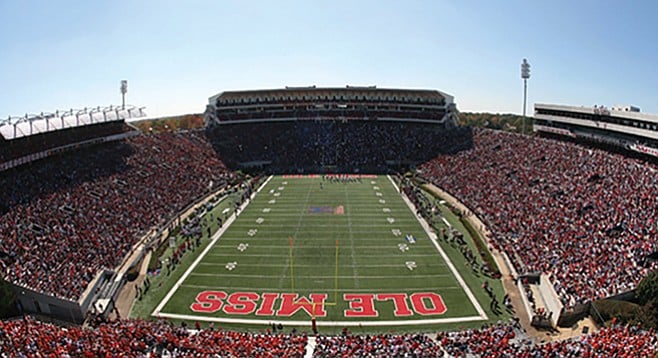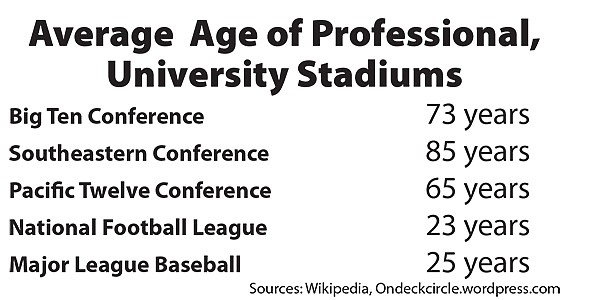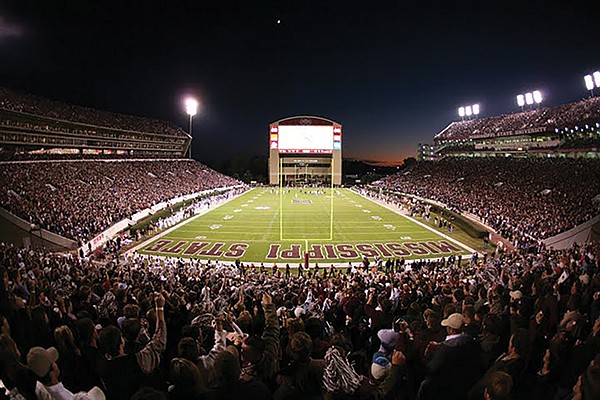 Facebook
Facebook
 X
X
 Instagram
Instagram
 TikTok
TikTok
 Youtube
Youtube

Read a sports-page article and you will hear Qualcomm Stadium described as a “dump,” a “pigsty,” “run-down,” or “ancient.” Ergo, San Diego taxpayers should shell out $1 billion or more to subsidize a new stadium for a football team that has been maneuvering to move to a greener pasture, Los Angeles, for more than a dozen years.
Whoa, Nellie. The stadium now named Qualcomm is only 48 years old — still in diapers, compared with big university stadiums.


The average age of a stadium in the Big Ten is 73; the Southeastern Conference, 85; and the Pac-12 Conference, 65. Major university teams such as Wisconsin, Ohio State, Nebraska, Illinois, Michigan State, Mississippi, Mississippi State, Texas A&M, Tennessee, Louisiana State, Vanderbilt, Washington, Southern California, Colorado, California–Berkeley, and California–Los Angeles play in stadiums more than 90 years old, although they have been expanded and renovated over the years.
By contrast, the average National Football League stadium is merely 23 years old, and the average Major League Baseball ballpark is age 25.
“Every [pro] team expects to get a new stadium every 25 or 30 years,” says sports finance expert Roger Noll, professor of economics emeritus at Stanford.
Government-subsidized sports stadiums are now amusement parks for billionaire owners. The athletic contest is no longer the primary attraction. New stadiums have posh restaurants, stores, gift shops, museums, electronic scoreboards featuring close-up replays, themed entertainment, luxury boxes and seats, and all manner of amenities appealing to the rich and chic. Therefore, prices zoom as citizens willingly vote to price themselves out of sporting events.
Revenues from these upscale amenities are growing faster than other team-related revenues, says Noll, and that’s why owners “are finding more and more ways to get people to spend money inside a stadium.” After a stadium becomes 25 or 30 years old, the team owner sees confreres generating all that cash “and they want to replicate it.”
And why not? Taxpayers, generally, are picking up 70 to 80 percent of the tab.
The madness began in the early 1960s in Houston and escalated throughout the nation. That history is key to the San Diego Chargers’ attempt to escape northward, where entertainment-industry billionaires will devour the luxuries.
The villain was Houston’s Astrodome, hailed as the Eighth Wonder of the World when it opened in 1965. Baseball could be played in air-conditioned bliss during that city’s hideously hot summers. There were 55 luxury boxes — the first of their kind.
Soon, subsidized domed stadiums replete with luxury amenities were popping up all over. Some have already been razed. Although it was renovated in 1988, the Astrodome was abandoned by Houston’s pro football team in 1996 and baseball team in 1999.

The most pitiable victim of the luxury-stadium craze is St. Louis. The Cardinals had departed for Phoenix in 1988. Bereft of a pro football team, the river town felt inferior. It built a domed stadium with 100 percent public money and went looking for a tenant. Out in California, the Los Angeles Rams couldn’t draw fans and couldn’t wangle a subsidized stadium out of local governments. Entertainer Georgia Frontiere had inherited majority ownership of the Rams after the death of her sixth husband, Carroll Rosenbloom, a high roller and investor in Bahamian gambling assets, according to investigative journalist Dan Moldea.
Frontiere (who married a seventh time after Rosenbloom’s death) decided to move the Rams to St. Louis. A shrewd assistant handled the negotiations with the city, desperate to fill its stadium. The deal wound up being the worst lease in the history of the stadium swindle, according to Neil deMause of the website. The Rams pay only $250,000 in annual rent plus half of game-day expenses and get most luxury box and concession revenues and 75 percent of advertising and naming-rights fees. The team also got a $46 million relocation fee and a guarantee of $20 million a year profit from ticket sales.
The worst part, for St. Louis, was the so-called state-of-the-art clause. Incredibly, St. Louis agreed that it would keep the stadium in the top 25 percent of all National Football League stadiums. (The Kansas City Chiefs and Cincinnati Bengals have such a clause, and the Chargers gave up theirs in 2004.) The team could break the lease at ten-year intervals if it could show that the facility was not in the top 25 percent. The contract specified that the stadium must be first tier in such components as luxury boxes, scoreboards, concession areas, restrooms, and electronic and telecommunications equipment, according to Marquette Sports Law Review.
Among those representing St. Louis in the one-sided deal were two iconic Missouri politicians: Representative Richard Gephardt, who had tried to be nominated for president, and Senator Tom Eagleton, who thought he would be vice president until his psychiatric treatments became known.
The Rams occupied the stadium in 1995. The 20-year contract reevaluation period ended this year. Twenty-one new stadiums have been built since 1995. Two years ago, an arbitrator ruled that it would take a $700 million renovation — essentially a teardown — to bring the dome to first-tier status.
Georgia Frontiere died in 2008, and the ownership passed in steps to Stan Kroenke, a multibillionaire who is married to another multibillionaire. Kroenke has purchased land in Inglewood in the Los Angeles market and wants to build a $1.9 billion, hypermodern stadium with private funds. Missourians now want to build a new stadium with public funds to keep him in St. Louis.
It’s assumed he will try to move the Rams to Inglewood. The National Football League could try to block him, but that’s not likely. It tried to block Frontiere’s move, too, but backed down after she threatened to sue.
Sports experts such as Noll think Kroenke will succeed in moving the Rams to Los Angeles. Some believe he will want another team to be a tenant in the stadium. It’s a good bet that the Chargers would love to be that other team, although ownership insists it prefers to share a new stadium in Carson with the Oakland Raiders. (Don’t believe that.) Admitting it covets the L.A. market, the Chargers have flipped the bird at San Diego, so staying home would be quite difficult, especially since the team would lose its large L.A. audience.
San Diego, with its moderate incomes, high cost of living, relative paucity of billionaires and multimillionaires, and small TV market, may no longer be cut out to host a National Football League team. Blame the Astrodome.


Read a sports-page article and you will hear Qualcomm Stadium described as a “dump,” a “pigsty,” “run-down,” or “ancient.” Ergo, San Diego taxpayers should shell out $1 billion or more to subsidize a new stadium for a football team that has been maneuvering to move to a greener pasture, Los Angeles, for more than a dozen years.
Whoa, Nellie. The stadium now named Qualcomm is only 48 years old — still in diapers, compared with big university stadiums.


The average age of a stadium in the Big Ten is 73; the Southeastern Conference, 85; and the Pac-12 Conference, 65. Major university teams such as Wisconsin, Ohio State, Nebraska, Illinois, Michigan State, Mississippi, Mississippi State, Texas A&M, Tennessee, Louisiana State, Vanderbilt, Washington, Southern California, Colorado, California–Berkeley, and California–Los Angeles play in stadiums more than 90 years old, although they have been expanded and renovated over the years.
By contrast, the average National Football League stadium is merely 23 years old, and the average Major League Baseball ballpark is age 25.
“Every [pro] team expects to get a new stadium every 25 or 30 years,” says sports finance expert Roger Noll, professor of economics emeritus at Stanford.
Government-subsidized sports stadiums are now amusement parks for billionaire owners. The athletic contest is no longer the primary attraction. New stadiums have posh restaurants, stores, gift shops, museums, electronic scoreboards featuring close-up replays, themed entertainment, luxury boxes and seats, and all manner of amenities appealing to the rich and chic. Therefore, prices zoom as citizens willingly vote to price themselves out of sporting events.
Revenues from these upscale amenities are growing faster than other team-related revenues, says Noll, and that’s why owners “are finding more and more ways to get people to spend money inside a stadium.” After a stadium becomes 25 or 30 years old, the team owner sees confreres generating all that cash “and they want to replicate it.”
And why not? Taxpayers, generally, are picking up 70 to 80 percent of the tab.
The madness began in the early 1960s in Houston and escalated throughout the nation. That history is key to the San Diego Chargers’ attempt to escape northward, where entertainment-industry billionaires will devour the luxuries.
The villain was Houston’s Astrodome, hailed as the Eighth Wonder of the World when it opened in 1965. Baseball could be played in air-conditioned bliss during that city’s hideously hot summers. There were 55 luxury boxes — the first of their kind.
Soon, subsidized domed stadiums replete with luxury amenities were popping up all over. Some have already been razed. Although it was renovated in 1988, the Astrodome was abandoned by Houston’s pro football team in 1996 and baseball team in 1999.

The most pitiable victim of the luxury-stadium craze is St. Louis. The Cardinals had departed for Phoenix in 1988. Bereft of a pro football team, the river town felt inferior. It built a domed stadium with 100 percent public money and went looking for a tenant. Out in California, the Los Angeles Rams couldn’t draw fans and couldn’t wangle a subsidized stadium out of local governments. Entertainer Georgia Frontiere had inherited majority ownership of the Rams after the death of her sixth husband, Carroll Rosenbloom, a high roller and investor in Bahamian gambling assets, according to investigative journalist Dan Moldea.
Frontiere (who married a seventh time after Rosenbloom’s death) decided to move the Rams to St. Louis. A shrewd assistant handled the negotiations with the city, desperate to fill its stadium. The deal wound up being the worst lease in the history of the stadium swindle, according to Neil deMause of the website. The Rams pay only $250,000 in annual rent plus half of game-day expenses and get most luxury box and concession revenues and 75 percent of advertising and naming-rights fees. The team also got a $46 million relocation fee and a guarantee of $20 million a year profit from ticket sales.
The worst part, for St. Louis, was the so-called state-of-the-art clause. Incredibly, St. Louis agreed that it would keep the stadium in the top 25 percent of all National Football League stadiums. (The Kansas City Chiefs and Cincinnati Bengals have such a clause, and the Chargers gave up theirs in 2004.) The team could break the lease at ten-year intervals if it could show that the facility was not in the top 25 percent. The contract specified that the stadium must be first tier in such components as luxury boxes, scoreboards, concession areas, restrooms, and electronic and telecommunications equipment, according to Marquette Sports Law Review.
Among those representing St. Louis in the one-sided deal were two iconic Missouri politicians: Representative Richard Gephardt, who had tried to be nominated for president, and Senator Tom Eagleton, who thought he would be vice president until his psychiatric treatments became known.
The Rams occupied the stadium in 1995. The 20-year contract reevaluation period ended this year. Twenty-one new stadiums have been built since 1995. Two years ago, an arbitrator ruled that it would take a $700 million renovation — essentially a teardown — to bring the dome to first-tier status.
Georgia Frontiere died in 2008, and the ownership passed in steps to Stan Kroenke, a multibillionaire who is married to another multibillionaire. Kroenke has purchased land in Inglewood in the Los Angeles market and wants to build a $1.9 billion, hypermodern stadium with private funds. Missourians now want to build a new stadium with public funds to keep him in St. Louis.
It’s assumed he will try to move the Rams to Inglewood. The National Football League could try to block him, but that’s not likely. It tried to block Frontiere’s move, too, but backed down after she threatened to sue.
Sports experts such as Noll think Kroenke will succeed in moving the Rams to Los Angeles. Some believe he will want another team to be a tenant in the stadium. It’s a good bet that the Chargers would love to be that other team, although ownership insists it prefers to share a new stadium in Carson with the Oakland Raiders. (Don’t believe that.) Admitting it covets the L.A. market, the Chargers have flipped the bird at San Diego, so staying home would be quite difficult, especially since the team would lose its large L.A. audience.
San Diego, with its moderate incomes, high cost of living, relative paucity of billionaires and multimillionaires, and small TV market, may no longer be cut out to host a National Football League team. Blame the Astrodome.
Comments